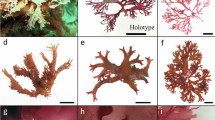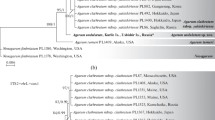Abstract
Melosira is one of the most common diatom genera found in freshwater ecosystems. There are many freshwater species of Melosira, of which M. varians is the most common. In our investigation of periphytic diatoms in the Jinsha River, China, a new species, M. capsularum sp. nov, was characterized in combined morphological and molecular approaches. M. varians was also analyzed using molecular data. The new species is similar to M. varians, M. moniliformis, M. nummuloides, and M. lineata in morphology. The cells are capsular and join to filaments by mucilage pads that are secreted on the valve face and united into pairs by their cingula. The valve face is domed and covered with small granules, and the valve mantle edge has a milled appearance. The two strains of M. capsularum are in a single clade obviously away from other Melosira species, as determined in phylogenetic analysis based on nuclear small subunit (SSU) rDNA sequences and the chloroplast-encoded rbcL gene. Thus, the results of morphological comparisons and phylogenetic analysis based on molecular data provide strong evidence that M. capsularum is a new species, thereby increasing the total number of recognized freshwater diatom species in China. In addition, we have systematically reclassified the freshwater Melosira that have been recorded in China.
Similar content being viewed by others
Data Availability Statement
All of the data obtained and/or analyzed in this study are available from the corresponding author upon request.
References
Agardh C A. 1824. Systema algarum. [1]–312. Lundae [Lund]: Literis Berlingianis [Berling].
Alverson A J, Jansen R K, Theriot E C. 2007. Bridging the Rubicon: phylogenetic analysis reveals repeated colonizations of marine and fresh waters by thalassiosiroid diatoms. Molecular Phylogenetics and Evolution, 45(1): 193–210, https://doi.org/10.1016/j.ympev.2007.03.024.
Chen J Y, Zhu H Z. 1985. Studies on the freshwater Centricae of China. Acta Hydrobiologica Sinica, 9(1): 80–83. (in Chinese with English abstract)
Cleve P T. 1883. Diatoms collected during the expedition of the Vega. Vega-Expedition Vetenskåpliga Iakttagelser Bearbetade of Deltagare I Resan Och Andra Forskare untgifna af A.E. Nordenskiöld, 3: 457–517.
Crawford R M. 1975a. The frustule of the initial cells of some species of the diatom genus Melosira C. Agardh. Nova Hedwigia, 53: 37–50.
Crawford R M. 1975b. The taxonomy and classification of the diatom genus Melosira C.Ag. I. The type species M. nummuloides C.Ag. British Phycological Journal, 10(4): 323–338, https://doi.org/10.1080/00071617500650351.
Crawford R M. 1977. The taxonomy and classification of the diatom genus Melosira C. Ag. II. M. moniliformis Phycologia, 16(3): 277–285, https://doi.org/10.2216/i0031-8884-16-3-277.1.
Crawford R M. 1979. Filament formation in the diatom genus Melosira Ag. and Paralia Heiberg. Nova Hedwigia, 64: 121–133.
Edgar S M, Theriot E C. 2004. Phylogeny of Aulacoseira (Bacillariophyta) based on molecules and morphology. Journal of Phycology, 40(4): 772–788, https://doi.org/10.1111/j.1529-8817.2004.03126.x.
Felsenstein J. 1981. Evolutionary trees from DNA sequences: a maximum likelihood approach. Journal of Molecular Evolution, 17(6): 368–376, https://doi.org/10.1007/BF01734359.
Florin M B. 1970. The fine structure of some pelagic freshwater diatom species under the scanning electron microscope. Svenska Botaniska Tidskrift, 64: 51–64.
Gao Q, Ni J R, Zhao X F, Chen W Z. 2019. Community structure characteristics of phytoplankton and their relationship with environmental factors in the typical section of Chin-sha River. Acta Scientiarum Naturalium Universitatis Pekinensis, 55(3): 571–579. (in Chinese with English abstract)
Gargas C B, Theriot E C, Ashworth M P, Johansen J R. 2018. Phylogenetic analysis reveals that the ‘Radial Centric’ diatom Orthoseira Thwaites (Orthoseiraceae, Bacillariophyta) is a member of a ‘Multipolar’ diatom lineage. Protist, 169(6): 803–825, https://doi.org/10.1016/j.protis.2018.08.005.
Gasse F. 1975. L’evolution des Lacs de l’Afar Central (Ethiopie et T.F.A.I.) du Plio-Pléistocéne A L’actuel: Reconstitution Des Paleomilieux Lacustres A Partir De L’etude Des Diatomees. Université de Paris VI, Paris.
Glezer Z I, Makarova I V, Moisseeva A I, Nikolaev V A. 1992. The diatoms of the USSR fossil and Recent. Vol. II. fasc. 2: Stephanodiscaceae, Ectodictyonaceae, Paraliaceae, Radialiplicataceae, Pseudopodosiraceae, Trochosiraceae, Melosiraceae, Aulacosiraceae. p.1–128.
Guindon S, Gascuel O. 2003. A simple, fast, and accurate algorithm to estimate large phylogenies by maximum likelihood. Systematic Biology, 52(5): 696–704, https://doi.org/10.1080/10635150390235520.
Guiry M D, Guiry G M. 2020. AlgaeBase. World-wide electronic publication, National University of Ireland, Galway. http://www.algaebase.org.
Hall T A. 1999. BioEdit: a user-friendly biological sequence alignment editor and analysis program for Windows 95/98/NT. Nucleic Acids Symposium Series, 41: 95–98.
Hartley B, Ross R, Williams D M. 1986. A check-list of the freshwater, brackish and marine diatoms of the British Isles and adjoining coastal waters. Journal of the Marine Biological Association of the United Kingdom, 66(3): 531–610, https://doi.org/10.1017/S0025315400042235.
Haworth E Y. 1990. Diatom name validation. Diatom Research, 5(1): 195–196, https://doi.org/10.1080/0269249X.1990.9705104.
Houk V. 2010. Re-examination of a Sphaerotermia and a Gaillonella from the Ehrenberg Collection, Berlin (Germany). Diatom Research, 25(2): 293–306, https://doi.org/10.1016/S1568-9883(02)00049-5.
Hustedt F. 1927a. Die Kieselalgen Deutschlands, Österreichs und der Schweiz unter Berücksichtigung der übrigen Länder Europas sowie der angrenzenden Meeresgebiete. Bd. VII: Teil 1: Liefrung 1. In: Rabenhorst’s Kryptogamen Flora von Deutschland, Österreich und der Schweiz. (Anon. Eds). p.[1]-272.
Hustedt F. 1927b. Fossile Bacillariaceen aus dem Loa-Becken in der Atacama-Wüste, Chile. Archiv für Hydrobiologie, 18(2): 224–251.
Krammer K. 1991. Morphology and taxonomy of some taxa in the genus Aulacoseira Thwaites (Bacillariophyceae). I. Aulacoseira distans and similar taxa. Nova Hedwigia, 52(1–2): 89–112.
Luo F, You Q M, Wang Q X. 2018. A new species of Genkalia (Bacillariophyta) from mountain lakes within the Sichuan Province of China. Phytotaxa, 372(3): 236–242, https://doi.org/10.11646/phytotaxa.372.3.7.
Müller O. 1898. Bacillariales aus den Hochseen des Riesengebirges. Forschungsberichte aus der Biologischen Station zu Plön, 6: 48–84.
Nardelli M S, Tremarin P I, Ludwig T A V, Bueno N C. 2016. Melosira (Diatomeae) taxa from the Iguaçu River in southern Brazil. Biota Neotropica, 16(4): e20160249, https://doi.org/10.1590/1676-0611-bn-2016-0249.
Ognjanova-Rumenova N G, Crawford R M. 2012. Morphology and ultrastructure of the fossil freshwater diatom Aulacoseira temperei. Diatom Research, 27(3): 107–119, https://doi.org/10.1080/0269249X.2012.696495.
Pantocsek J. 1902. Kieselalgen oder Bacillarien des Balaton. Resultate der Wissenschaftlichen Erforschung des Balatonsees, herausgegeben von der Balatonsee-Commission der Ung. Geographischen Gesellschaft. Bd 2(2). p.112.
Posada D. 2006. ModelTest Server: a web-based tool for the statistical selection of models of nucleotide substitution online. Nucleic Acids Research, 34: W700–W703, https://doi.org/10.1093/nar/gkl042.
Potapova M G, Minerovic A D, Veselá J, Smith C R. 2021. Diatom New Taxon File at the Academy of Natural Sciences (DNTF-ANS), Philadelphia. http://dh.ansp.org/dntf.
Qi Y Z. 1995. Flora Algarum Sinicarum Aquae Dulcis. Tomus IV, Bacillariophyta, Centricae. Science Press, Beijing.
Ronquist F, Huelsenbeck J P. 2003. MrBayes 3: Bayesian phylogenetic inference under mixed models. Bioinformatics, 19(12): 1572–1574, https://doi.org/10.1093/bioinformatics/btg180.
Ross R, Sims P A. 1973. Observation on family and generic limits in the centric diatoms: a suggested terminology, Br. Journal of Phycology, 7: 139–163.
Simonsen R. 1979. The diatom system: ideas on phylogeny. Bacillaria, 2: 9–71.
Skvortzov B V. 1929. Freshwater diatoms from Amoy, South China. The China Journal, 11(1): 40–44.
Skvortzov B V. 1937. Neogene diatoms from Eastern Shantung. Bulletin of the Geological Society of China, 17(2): 193–204.
Skvortzov B V. 1938. Subaërial diatoms from Pin-Chiang-Sheng Province, Manchoukuo. Philippine Journal of Science, 65(3): 263–281.
State Environmental Protection Administration, Editorial Board of Water and Wastewater Monitoring and Analysis Methods. 2002. Water and Wastewater Monitoring and Analysis Methods Fourth Edition. China Environmental Science Press, Beijing.
Thompson J D, Gibson T J, Plewniak F, Jeanmougin F, Higgins D G. 1997. The CLUSTAL_X windows interface: flexible strategies for multiple sequence alignment aided by quality analysis tools. Nucleic Acids Research, 25(24): 4876–4882, https://doi.org/10.1093/nar/25.24.4876.
Thwaites G H K. 1848. Further observations on the Diatomaceae with descriptions of new genera and species. Annals and Magazine of Natural History, Series 2, 1: 161–172.
Trifonova I, Genkal S. 2001. Species of the genus Aulacoseira Thwaites in lakes and rivers of north-western Russia — distribution and ecology. In: Proceedings of the 16th International Diatom Symposium. Amvrosiou Press, Athens, Greece. p.315–324.
Van Heurck H. 1882. Synopsis des Diatomees de Belgique. p.78–103.
Author information
Authors and Affiliations
Corresponding author
Additional information
Supported by the Biodiversity Survey and Assessment Project of the Ministry of Ecology and Environment, China (No. 2019HJ2096001006) and the National Natural Science Foundation of China (No. 31770222)
Electronic supplementary material
Rights and permissions
About this article
Cite this article
Yang, L., Yu, P., You, Q. et al. Morphological and phylogenetic analysis of a new Melosira species and revision of freshwater Melosira in China. J. Ocean. Limnol. 40, 712–728 (2022). https://doi.org/10.1007/s00343-021-0470-x
Received:
Accepted:
Published:
Issue Date:
DOI: https://doi.org/10.1007/s00343-021-0470-x




